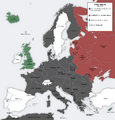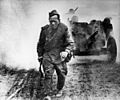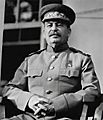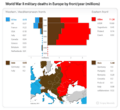Eastern Front (World War II) facts for kids
The Eastern Front was a huge and very important part of World War II. It was a major fight between the Axis countries (mainly Germany) and the Soviet Union. This conflict started in 1941 with a surprise attack by Germany called Operation Barbarossa. It finally ended in 1945 when Soviet soldiers captured Berlin, the capital of Germany.
Millions of soldiers fought on both sides, and the battles were incredibly tough. In the Soviet Union, this war is often called "The Great Patriotic War." In other parts of Europe and America, it's sometimes known as "The Soviet-German War." Most of the Axis soldiers who died in World War II lost their lives on the Eastern Front. Sadly, millions of Soviet soldiers and many civilians also died. This front was the most important conflict in Europe during World War II.
Contents
What Was the Eastern Front?
The Eastern Front was the name for the fighting that happened in Eastern Europe during World War II. It stretched for thousands of miles, from the Baltic Sea in the north to the Black Sea in the south. This made it the largest land battlefront in history.
Who Fought on the Eastern Front?
The main groups fighting were Nazi Germany and its allies (the Axis countries) against the Soviet Union. Germany's allies included countries like Romania, Hungary, Italy, and Finland. The Soviet Union was also known as the USSR.
Axis Countries and the Soviet Union
The Axis countries were led by Adolf Hitler of Germany. He wanted to expand Germany's power and control. The Soviet Union was led by Joseph Stalin. Both leaders had very different ideas about how the world should be.
Why Did the War Start Here?
Germany launched a surprise attack on the Soviet Union in June 1941. This attack was called Operation Barbarossa. Hitler wanted to defeat the Soviet Union quickly. He also wanted to gain control of its resources, like oil and farmland.
Operation Barbarossa Begins
On June 22, 1941, millions of German soldiers invaded the Soviet Union. They used many tanks and airplanes. The Soviet army was not fully ready for such a massive attack. German forces advanced very quickly at first.
Early German Advances
The German army pushed deep into Soviet territory. They surrounded many Soviet cities. They reached close to Moscow, the Soviet capital. Many Soviet soldiers were captured or killed in these early battles.
Key Moments of the Eastern Front
The war on the Eastern Front lasted for nearly four years. It involved some of the biggest and most brutal battles in history. The fighting was often in harsh weather, including freezing winters.
The Battle of Stalingrad
One of the most famous battles was the Battle of Stalingrad (1942-1943). German forces tried to capture the city of Stalingrad. Soviet soldiers fought very hard to defend it. This battle was a turning point in the war. The German army suffered a huge defeat here.
Turning the Tide
After Stalingrad, the Soviet army began to push back. They started to win more battles. They received some supplies from their allies, like the United States and Britain. The Soviet forces slowly gained strength.
The Battle of Kursk
Another massive battle was the Battle of Kursk in 1943. This was the largest tank battle in history. Thousands of tanks clashed in a huge fight. The Soviet Union won this battle. This victory further weakened the German army.
Soviet Counter-Attacks
From 1943 onwards, the Soviet army launched many powerful attacks. They pushed the German forces out of Soviet territory. They then began to advance into Eastern Europe. They liberated countries that Germany had occupied.
The Final Push to Berlin
By 1944, the Soviet army was moving steadily towards Germany. They fought their way through Poland and other countries. The German army was running out of soldiers and supplies.
The Fall of Berlin
In April 1945, Soviet forces reached Berlin. They surrounded the city. The Battle of Berlin was the last major battle in Europe. German soldiers fought hard, but they were outnumbered.
War Ends in Europe
On May 2, 1945, Berlin fell to the Soviet army. A few days later, on May 8, 1945, Germany officially surrendered. This marked the end of World War II in Europe. The Eastern Front had played a huge role in this victory.
Impact and Legacy
The Eastern Front was incredibly costly in terms of lives. Millions of soldiers and civilians died. Many cities and towns were destroyed. The war left a deep impact on the people of the Soviet Union and Eastern Europe.
Human Cost
The Soviet Union suffered the most deaths of any country in World War II. This includes both soldiers and civilians. The war also caused immense suffering and displacement. Many families were torn apart.
A Different View of the War
For the Soviet Union, the Eastern Front was their main fight against Nazi Germany. It is remembered as a time of great sacrifice and heroism. It shaped their history for many years to come.
Images for kids
-
Semyon Timoshenko and Georgy Zhukov in 1940
-
Situation in Europe by May/June 1941, immediately before Operation Barbarossa
-
Europe at the height of German military expansion, 1942
-
Wehrmacht soldiers pulling a car from the mud during the rasputitsa period, November 1941
-
German soldiers surrendering to the Red Army units near Vitovka village, 1941
-
Soviet soldiers pushing a 45 mm (1.8 in) anti-tank gun on the road, 1 August 1943
-
The Battle of Prokhorovka was one of the largest tank battles ever fought. It was part of the wider Battle of Kursk.
-
The Red Army is greeted in Bucharest, Romania, August 1944.
-
German refugees from East Prussia, February 1945
-
Citizens of Leningrad during the 872-day siege, in which about one million civilians died
-
Adolf Hitler led Germany during World War II.
-
Hitler with generals Friedrich Paulus, Adolf Heusinger and Fedor von Bock in Poltava, German-occupied Ukraine, June 1942
-
Joseph Stalin led the Soviet Union during World War II.
-
Homeless Russian children in occupied territory (about 1942)
-
A German war cemetery in Estonia
See also
 In Spanish: Frente oriental (Segunda Guerra Mundial) para niños
In Spanish: Frente oriental (Segunda Guerra Mundial) para niños

































